|
|
|
Sort Order |
|
|
|
Items / Page
|
|
|
|
|
|
|
| Srl | Item |
| 1 |
ID:
129652
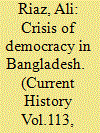

|
|
|
|
|
| Publication |
2014.
|
| Summary/Abstract |
Since its independence in 1971, Bangladesh has experienced tumultuous times. The country endured prolonged military rule from 1975 to 1990, but democratic aspirations have defined the course of its politics. In the past four decades, Bangladesh has experimented with various systems of governance, including one party presidential rule and, currently, a multiparty parliamentary system, having returned to parliamentary democracy in 1991. Bangladesh has demonstrated favorable elements of democracy, such as high levels of political participation, a plethora of political parties, a growing middle class, a vibrant civil society, and periodic elections. Yet the nation has undergone repeated reversals of democratic gains, thanks to civilian authoritarianism and military dictatorship. The polity has suffered from an absence
of strong institutions to ensure the rule of law, accountability, and transparency in governance.
|
|
|
|
|
|
|
|
|
|
|
|
|
|
|
|
| 2 |
ID:
129653
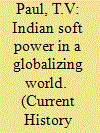

|
|
|
|
|
| Publication |
2014.
|
| Summary/Abstract |
Soft power-based on intangible indicators such as culture, civilization, literature, philosophy, involvement in global institutions, diplomacy, political organization, and state capacity-has emerged as an important factor in the globalizing world for nations seeking higher status and influence. But an appraisal of India's present and putative soft power assets underscores the need for greater hard power resources in order to harness soft power more effectively. Indeed, soft power without hard power is a chimera, and they should not be seen in oppositional terms, especially for an aspiring global power. Hard power sources include military, economic, demographic, and technological assets. As defined by Harvard's Joseph S. Nye Jr. in his 2004 book Soft Power: The Means to Success in World Politics, soft power "is the ability to get what you want through attraction rather than coercion or payments. It arises from the attractiveness of a country's culture, political ideals, and policies. When our policies are seen as legitimate in the eyes of others, our soft power is enhanced." Yet a country relying solely on soft power without hard power assets can find its weaknesses exposed easily. This happened to India in 1962, when China inflicted a humiliating military defeat on it, tarnishing New Delhi's hard-won soft power position in the world, especially among other de.
|
|
|
|
|
|
|
|
|
|
|
|
|
|
|
|
| 3 |
ID:
129648
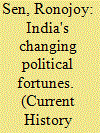

|
|
|
|
|
| Publication |
2014.
|
| Summary/Abstract |
India is due to hold a general election in April- May 2014, and speculation about the shape of the next government in New Delhi has reached a fever pitch. The presence of a new political player-the Common Man's Party (Aam Aadmi Party, or AAP)-has thrown open a contest that was already going to be difficult to call. Election forecasting in India is a perilous task in any case, given the country's diversity and fragmented politics. Nonetheless, certain broad trends can be discerned. One is the parlous state of the country's oldest party, the Indian National Congress. The Congress has been in government during much of independent India's history. For the past decade it has governed the nation as the leader of the United Progressive Alliance (UPA), and its popularity has steadily declined. After the 2014 general election, it is unlikely to be in a position to form a new government.
|
|
|
|
|
|
|
|
|
|
|
|
|
|
|
|
| 4 |
ID:
129650


|
|
|
|
|
| Publication |
2014.
|
| Summary/Abstract |
Among the most distinctive features of US President Barack Obama's counterterrorism strategy has been his reliance on unmanned aerial vehicles-more commonly known as drones-to target terrorist operatives around the globe. The use of drones has rapidly expanded beyond the battlefields where US troops have openly engaged in conflict, such as Afghanistan and Iraq, to a range of undeclared combat zones, including Pakistan, Yemen, and Somalia. According to an official estimate, the US military launched in 1,160 drone strikes in Afghanistan alone between 2009 and 2012.
|
|
|
|
|
|
|
|
|
|
|
|
|
|
|
|
| 5 |
ID:
129654
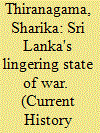

|
|
|
|
|
| Publication |
2014.
|
| Summary/Abstract |
In November 2012, workers digging in the compound of a hospital in Matale, in central Sri Lanka, uncovered human remains. A full excavation revealed some 154 skeletons. Forensic reports point to signs of torture on the bodies and evidence of unnatural deaths (such as decapitation). Artifacts buried with the bodies indicate a time frame of 1986-90, precisely the period of fighting between the Sri Lankan state and the Sinhalese nationalist insurrectionary group Janatha Vimukthi Peramuna (JVP), which resulted in an estimated 60,000 missing and feared dead. Officials have rejected the dating of the bodies and claim that they are from the 1940s. North of Matale are the areas where the final battles of Sri Lanka's civil war took place. Many analysts, including members of the United Nations agency tasked with investigating accounts of the last battles, suggest that nearly 40,000 Tamil civilians died there between February and May 2009. In January of this year, another mass grave was uncovered, this time in northern Mannar. The
state claims that it contains the remains of those killed by the Tamil Tigers, also known as the Liberation
Tigers of Tamil Eelam (LTTE); civil society figures argue that the dead were victims of the army. Excavation has halted, and the Archaeological Board has suggested that this site might in fact be a normal cemetery.
|
|
|
|
|
|
|
|
|
|
|
|
|
|
|
|
| 6 |
ID:
129651
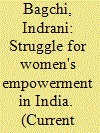

|
|
|
|
|
| Publication |
2014.
|
| Summary/Abstract |
The young woman was caught by tribal elders of the village, apparently in the company of a Muslim man. She was no ordinary tribal woman-driven by poverty, she had left her sleepy village in the Birbhum district of West Bengal state to live and work in a big city. Now she had a sizable disposable income. The
panchayat (tribal elders council) demanded that she pay a fine for being seen with a Muslim man. The man paid up. She refused. The panchayat ordered that she be tied up and gang-raped by 11 men. The "punishment" was as much for the fact that she had rejected the lot of the women in the village as for her entanglement with a Muslim man. It was intended as a warning to other women who might contemplate similar relationships. This happened on January 21, 2014. All the men, including the headman of the village, have been arrested; the district police chief
|
|
|
|
|
|
|
|
|
|
|
|
|
|
|
|
|
|
|
|
|